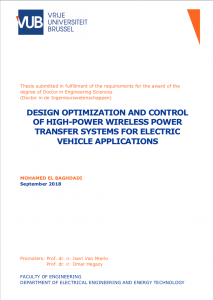
Nowadays, wireless power transfer (WPT) systems are one of the promising electric vehicle (EV) charging technologies that cannot only improve the overall charging process, but also reduce the on-board battery systems required, by charging more frequently. This WPT system comprises two parts: 1) In the vehicle there is the power pick-up unit (secondary WPT winding and its power electronics interfaces) and 2) at grid side there is a primary pad (primary winding and its power electronics interfaces) connected to the Electric Vehicle Supply Equipment. Today there are still many design and control challenges to it, resulting in oversized EV energy storage systems and in low power quality and efficiency that should be overcome and improved.
Thus, one of the main objectives of this PhD work is to improve the overall battery charging process by making it more user-friendly and by reducing the charging process and time in an innovative way. This results in re-scaling of the required battery pack in EVs with improved charging concepts. Therefore, the research focuses on the development of WPT systems for the charging of EVs (such as electric buses) and their charging energy-management strategies.
During this PhD research, to design the EV charging management strategy and to define the technical specifications of a WPT system, novel advanced EV simulation models are developed, fine-tuned and implemented. With these simulations, insight is gained in the power flows in EVs with different energy sources (i.e. batteries, ultra-capacitors, WPT systems, etc.). The requirements for EVs (especially electric buses with WPT systems) are investigated thoroughly by way of simulations. This research also provides the required power and energy levels along the trajectories during driving. Moreover, innovative charging management strategies for the combined use of WPT and energy-storage units like batteries are developed. This serves as a motivation for the dimensioning and configuration of the proposed WPT systems.
The design of WPT systems has been studied and the magnetic design supported by analytical equations and finite elements modeling and simulation is performed for a newly developed 22kW WPT system that can be apprehended for bus or passenger car applications.
Next to the magnetics and WPT coils design, a novel control for the power electronics interfaces is developed and innovative bidirectional power flow is included. Thus, the control allows for both vehicle-to-grid (V2G) as grid-to-vehicle (G2V) scenarios with this WPT system.
Finally, this study is concluded by development of the proposed 22kW WPT system. A laboratory prototype has been developed and built to experimentally validate the operational performance of the proposed modular and scalable system.
